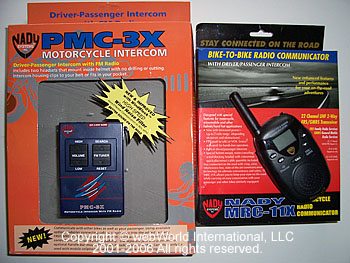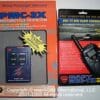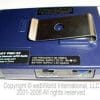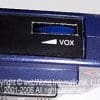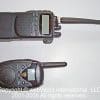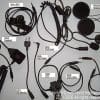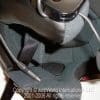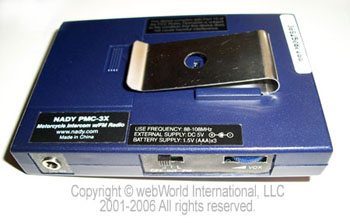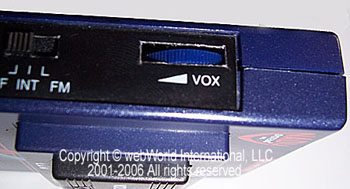The folks at Nady Systems have produced a trio of small, lightweight motorcycle communication systems, the PMC-2X intercom, the PMC-3X intercom with FM radio and a bike-to-bike communications system called the MRC-11X.
The PMC-3X intercom with FM radio is powered by three AAA batteries or the motorcycle’s electrical system using the optional battery eliminator.
The PMC-3X comes with two MO-1 headsets, comprised of a single earpiece and microphone boom combination. They can fit into virtually any helmet, including full-face units.
The PMC-3X has a built-in FM (monaural) tuner, a voice-activated (VOX) intercom and inputs for a 2 way radio with PTT (push to talk) or VOX operation (depending upon your handheld radio) and another source via an AUX (auxiliary) input (such as an iPod or Walkman).
Product Details
The unit has a belt-clip, but the clip is poorly designed and will allow the unit to slide off downward while wearing it. This could create a unique situation should this happen while riding the motorcycle!
Headsets are connected via coiled cords to 1/8″ jacks on the PMC units, which are clearly labeled for driver and passenger.
Communications between the driver and passenger are automatically leveled while listening to the FM radio. Once communications are initiated, the music level or source level is lowered and it returns approximately three seconds after communications cease.
The voice-activation sensitivity is controlled via a manual dial adjustment. The wheel is very small and recessed, making it difficult to access and adjust while riding — especially if you are wearing gloves. It’s important to have easy access to the unit and the adjustment dial, as wind conditions can change drastically when riding a motorcycle, which limit the usefulness of the PMC-3X.
When the microphones are opened, the music in the background is lowered to the point where it becomes very difficult to hear. Thus, if the wind noise is opening the microphone you’ll hear only that sound amplified inside your helmet instead of the music.
Using the Nady Intercoms
In optimal conditions, the unit works very well. The conversations are full-duplex and have decent audio quality, depending upon the helmet style and wind noise.
When using the AUX input, the “Intercom” must be selected first for the mode on the PMC-3X, which leaves the driver to passenger channel open continuously, and the audio level does not automatically lower the input level as it does in FM mode.
Operating the FM radio and headset volume is fairly simplistic. The volume has roughly six levels which are adjusted via a large rocker-style button. It is easy to operate even without looking at the unit.
Tuning the FM radio uses the same style of button, although the operation is unique. FM tuning starts at the bottom of the band (88.1) and goes up in increments of .2 as the rocker is pressed. If it is pressed down, the radio will return to the starting point of 88.1 — which if done accidentally, can be rather annoying.
The FM tuner works well in populated areas, but mine was worthless after I moved 15-20 miles away from the transmission source. A local device with an FM transmitter, such as a satellite radio receiver or other types of personal audio devices may produce better results due to the proximity of the transmission source.
For those with an FRS (Family Radio Service, U.S.A. only), GMRS (General Mobile Radio Service) or CB (Citizen’s Band) handheld radio that has VOX capability, the units can plug directly into the PMC-3X’s radio input to provide hands-free two-way communication to other motorcyclists nearby.
I’ve used the MRC-11X as well as a hand-held Radio Shack unit (model TRC-241) for testing. The TRC-241 does not have VOX, but the cables provided with the headsets included a PTT (push to talk) button that can be attached to any convenient location using Velcro — in my case on the throttle near my right thumb. PTT operation is straightforward and works very well.
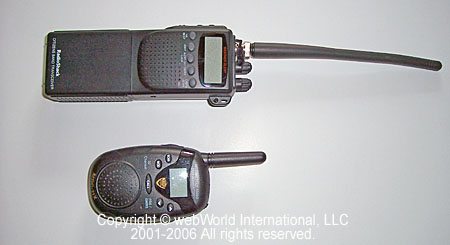
Issues
Another drawback with the PMC series is the MO-1 headsets. While this may not be an issue for some people, I found that not having the sound coming from both ears is annoying. Purchasing the optional OCA-XO (open face) or OCA-XC (closed face) series of headsets helps with this, as the helmet then has two earpieces that balance out the overall sound although it is still monaural.
The headsets are connected via a coiled cable to the PMC. There is a quick disconnect point in the form of a “pig tail” that is approximately 3 inches from the bottom of your helmet once it is installed.
The coiled cable continues to a 1/8″ jack for connection to the PMC main unit. The cable also has a “Y” for connecting in a PTT switch. The juncture of the “Y” is extremely fragile, and it is easy to accidentally pull these cables apart, rendering them useless.
I found that using the PTT that came with the PMC, rather than the one that came with the optional headset, is the better option – as it plugs directly into the PMC instead of being combined with the headset cable.
The optional headsets also come with a myriad of connecting cables, but there’s no documentation to assist the new owner with understanding which cable serves which purpose. After some experimentation, the three-ringed 1/8″ jack with red tape on it works with handheld CB radios, such as the aforementioned Radio Shack unit. The same cable without the red tape is for use in connecting the MRC-11X or auxiliary audio inputs.
The cell phone cable does work, although any called party tends to hear themselves echoed in the conversation. The may be a fault of the cell phone, or it may be a fault in the design on the Nady device. Regardless, I’ve been told it’s rather annoying to receive a call from me on the motorcycle due to this echo.
Bike to bike communications were tested with both the MRC-11X to another MRC-11X, and from CB to CB. In both cases, the lower the overall speed, the clearer the communication. None of the testing was conducted above 75 mph, and the average speed was 60 mph.
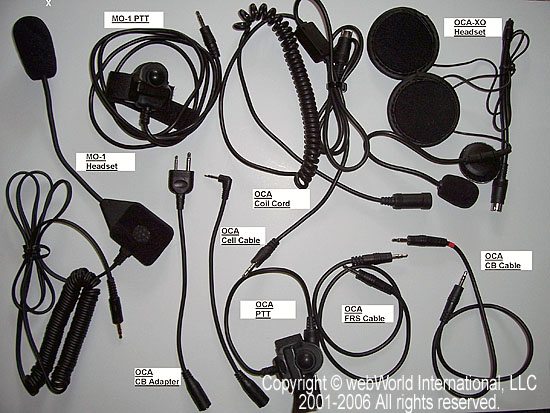
Nady MRC-11X
The MRC-11X is a combination FRS / GMRS radio with driver to passenger intercom capability and an AUX input for additional sources.
The unit can be used in PTT mode or VOX activated for 2 way radio usage, but unlike the PMC-3X the driver to passenger communications is always on when the unit is in intercom mode. I found this to be slightly annoying, because there was the constant sound of the background being amplified from the microphone and presented back in my headphones.
The AUX input provides additional flexibility, but no more than the PMC-3X and you’ve lost the FM tuner capability, unless the auxiliary device you are using contains one. The interface for controlling the features on the MRC-11X requires some getting used to, and it isn’t terribly intuitive.
The users’ manual is an extremely valuable tool for navigating the otherwise cryptic menu system. The MRC-11X comes with one Nady MMHS11XO open face headset. Although it looks similar to the OCA-XO series of headsets, there’s mixed results when using these headsets with the PMC series; the combination usually produces high-level feedback inside the helmet.
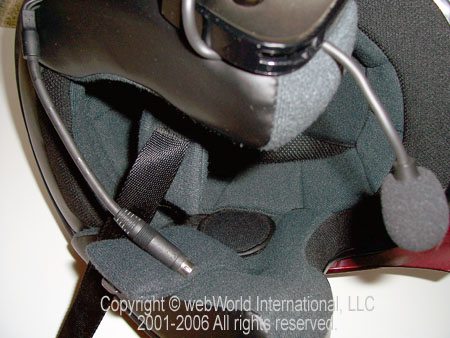
Nady OCA-XO Headset
When used in combination, the PMC-3X with OCA-XO type headsets and the MRC-11X or handheld CB plugged into the unit in makes an affordable and safe combination for motorcycle communications, whether it’s driver to passenger or bike to bike.
Bike to bike has much better results than driver to passenger, again based upon wind noise and road conditions. Experimentation is required to achieve the best results.
Conclusion
Ultimately, you must live by the old adage of “you get what you pay for” when purchasing motorcycle communicators.
If you’re on a limited budget and have patience, this might be an adequate solution for short distance riding. If you’re into distance riding or do not like experimentation, you might want to consider another option.
Owner Comments and Feedback
See details on submitting comments.


